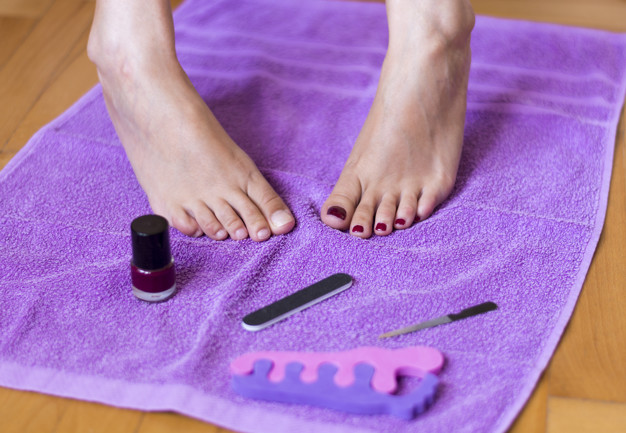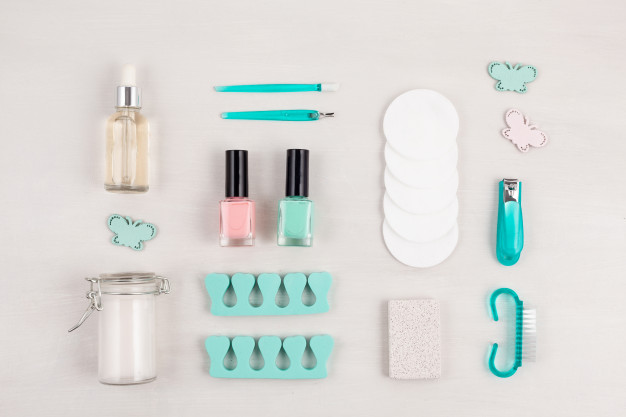Some nail bars may still be closed, but your feet don’t have to suffer. Here’s an expert guide to caring for your feet and trouble-shooting everything from hard skin to ingrown nails. Understandably, your feet may have not featured highly on your list of concerns for 2020. But now, with the weather often warm enough for sandals lockdown measures being eased, it is time to take a good look at those toes.
From cracked skin to fungal infections, many of you need more than just a lick of polish before unleashing your feet on the world – even if it is from a two-meter distance. With most nail salons still closed, it may be time to take matters into your own hands.
Here’s how to give yourself a simple and affordable pedicure at home.
Trim your nails

Untrimmed nails can become painful if they dig into the toes, as can a build-up of hard or cracked skin. Don’t wait until your nails are really long and the hard skin is very thick before you take action. Cut and file your nails gently every two to three weeks. And use a file on your hard skin a couple of times a week. Apply foot cream every day.
Is it possible to give yourself a good DIY pedicure?

As long as you can comfortably reach your feet, then yes. It is worth investing in a pumice stone or skin file and a good pair of nail clippers (“The ones that look like small pliers”) before you get started.
Soak your feet in warm water with a mild soap.
Start by soaking your feet in warm water with a mild soap. “Use a sponge to give them a good scrub, then dry well, paying particular attention to the areas between the toes. Use your pumice stone or skin file to gently rub any areas of rough or thickened skin.

Then, cut your nails using the clippers, going either straight across or giving them a slightly rounded shape. “Do not cut down the sides of your nails, as this can cause ingrown toenails,” experts warn. Smooth the edges of the nails using a nail file. Finally, apply a foot cream. It is recommended to use one with 10% urea in it. If you have very dry skin or cracked heels, you could step it up to 25%.
What about the cuticles?
Pushing back cuticles – AKA the eponychium, a thickened layer of skin at the base of the nail – is common practice as part of manicures and pedicures at most nail salons, but podiatrists do not approve.

Never push back cuticles. The cuticle is there for a good reason and pushing it back can lead to paronychia, which is an infection of the skin around the nail. The condition causes pain, redness and swelling around the affected area.
Can I do it wrong?
Use a skin file to gently rub any areas of rough or thickened skin.
A basic pedicure is fairly straightforward, but there are a few things to watch out for. Ripping the toenails is a big problem. Often times, people seem to cut the nail a bit and then just yank the last bit off, with a bit of skin as well, and then you can be in trouble. Experts caution against using blades or other sharp implements on your feet, even if the skin is really tough.

Don’t dig and scrape into the corner of nails. If you can see a bit of sock or skin down the side of your nail, but it’s not bothering you, then don’t worry about it.
What if I have an ingrown toenail?
Again, experts advise a hands-off approach. Leave in-growing toenails alone – maybe soak it in warm salt water to try to keep it clean. If you’re lucky, the problem will subside, but digging around can make it worse. If it does not, consult a podiatrist.
What about fungal infections?
Fungal skin infections, such as athlete’s foot, are common and usually start between the toes. Symptoms can include itching, cracked or blistered skin. If left untreated, the infection can spread to your toenails, causing thickening and discolouration.

Experts advise washing your feet in tepid water and drying thoroughly using kitchen roll, so that it can be disposed of and you are not passing the possibility of infection to someone else in your household. Also, dab to dry them – don’t rub, as that can damage the delicate infected skin.
Apply cream on your feet every day.
Then apply an antifungal cream and repeat the whole process twice a day. The infection thrives in the warm, dark, moist environment of shoes, so it is advisable to swap between pairs every day. This gives them time to dry out properly. You should wear fresh socks daily, which should be washed at a high temperature. Natural fibres such as cotton and especially bamboo are a big help. “Maintaining a good foot hygiene routine will help keep the symptoms at bay.

Although some salons are closed, many podiatrists are still seeing patients, so it is worth getting in touch if you require urgent care. They can also advise on other foot conditions such as verrucas and corns, which can often be remedied with over-the-counter treatments.
On a final note, please wear shoes. If you’re walking around barefoot at home, feet do tend to dry out a lot more than if you’re wearing shoes and socks.

If you have developed a lockdown slipper habit, that could also be bad news for your feet. “Try to wear good-fitting shoes or trainers at least once a day.
